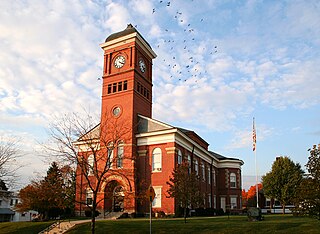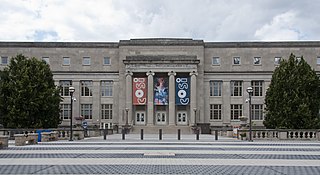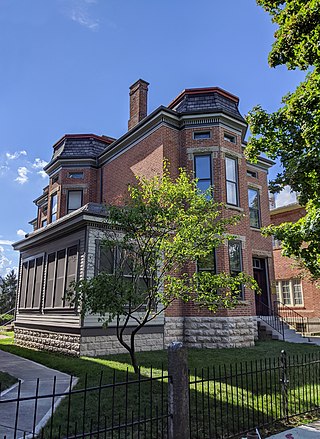
Mount Gilead is a village and the county seat of Morrow County, Ohio, United States. It is located 41 miles (66 km) northeast of Columbus. The population was 3,503 at the 2020 census. It is the center of population of Ohio. The village was established in 1832, eight years after white settlers arrived in the region. Before their arrival, the forest was a hunting area for the Shawnee tribe.

The Irwin Conference Center was designed by Eero Saarinen and built in 1954 in Columbus, Indiana, United States. It is currently owned and operated by Cummins, whose world headquarters is located across Jackson Street in the Cummins Corporate Office Building. In recognition of its unique and beautiful design, the resource was designated a National Historic Landmark by the National Park Service in 2001.

Spaghetti Warehouse is an Italian restaurant chain geared towards families with five physical locations in two U.S. states: four in Ohio, one in New York (state). They also operate a to-go only location in Texas. The chain started in 1972 in Dallas, Texas, and at one point had spread throughout the southern and eastern parts of the United States. Each restaurant has a trolley car in the dining room and patrons are able to sit in the car. One of Spaghetti Warehouse's unique characteristics is that many of the older locations are in renovated, historic buildings.
The Jeffersonville, Madison and Indianapolis Railroad (JM&I) was formed in 1866 as a merger between the Indianapolis and Madison Railroad and the Jeffersonville Railroad.

The Peters Cartridge Company was a company located along the Little Miami River in Kings Mills, Ohio, which specialized in gunpowder and ammunition production. Founded in 1887 by Gershom Moore Peters, the company supplied military ammunition to various countries during both world wars. Following its demise in 1944, the site was repurposed by Columbia Records and later Seagram, before being abandoned in 1968 and falling into disrepair. Its historic buildings, built in 1916, were added to the National Register of Historic Places in 1985. A brewery and apartment complex themed to the defunct company was constructed on site in 2020, in which many structures were restored and the company's history was placed on display for guests.

Franklin Park Conservatory and Botanical Gardens is a botanical garden and conservatory located in Columbus, Ohio. It is open daily and an admission fee is charged. Today, it is a horticultural and educational institution showcasing exotic plant collections, special exhibitions, and Dale Chihuly artworks.

Ashland County Courthouse was constructed from 1928–1929 on West 2nd Street in Ashland, Ohio, United States. The courthouse was added to the National Register on 1979-12-21.

Central High School, also known as High School of Columbus and High School of Commerce, was a four-year secondary school located in Franklinton, Columbus, Ohio. It was a part of Columbus City Schools. On March 7, 1985, the 1924 school building was added to the National Register of Historic Places. It is considered part of the Columbus Civic Center Historic District.

This is a list of the National Register of Historic Places listings in Knox County, Ohio.

The Fulton County Courthouse, built in 1870, is a historic courthouse building located in Wauseon, Ohio. On May 7, 1973, it was added to the National Register.

The Courthouse of Crawford County, Ohio, is a landmark of the county seat, Bucyrus, Ohio. The courthouse was built in 1854 on East Mansfield Street by architect Harlan Jones and was added to the National Register of Historic Places on 1985-02-28 as a part of the Bucyrus Commercial Historic District.

The United States Post Office and Courthouse is a historic building in Downtown Columbus, Ohio. The structure was built from 1884 to 1887 as the city's main post office. The building also served as a courthouse of the United States District Court for the Southern District of Ohio from its completion in 1887 until 1934, when the court moved to the Joseph P. Kinneary United States Courthouse. The building was tripled in size from 1907 to 1912, and was rehabilitated for use as the Bricker & Eckler law offices in 1986, and today houses the same law firm.

The Hocking Valley Scenic Railway is a non-profit, 501c3, volunteer-operated tourist railroad attraction that operates out of Nelsonville, Athens County, Ohio. It is also located near the popular Hocking Hills State Park in nearby Hocking County. It uses former trackage of the Chesapeake & Ohio Railway, which was in turn originally Hocking Valley Railway trackage. The current operation was founded in 1972.

Saint Patrick Church is a historic building and the second-oldest Catholic church building in Columbus, Ohio. Located in the Discovery District neighborhood, the structure served as the pro-cathedral of the Roman Catholic Diocese of Columbus until the consecration of Saint Joseph Cathedral. It has been served by priests of the Dominican Order since 1885 and is currently home to an active parish.

Indianola Junior High School is a historic school building located on 19th Avenue in Columbus, Ohio. The building opened in 1929 after the school moved out of its previous location on 16th Avenue. It was added to the National Register of Historic Places in 1980.

The Columbus Landmarks Foundation, known as Columbus Landmarks, is a nonprofit historic preservation organization in Columbus, Ohio. The foundation is best-known for its list of endangered sites in the city and its annual design award, given to buildings, landscapes, and other sites created or renovated in Columbus. It was established in 1977 as a project of the Junior League of Columbus, Ohio, following the demolition of the city's historic Union Station. It is headquartered at 57 Jefferson Avenue, a contributing structure in the Jefferson Avenue Historic District in Downtown Columbus.

The former Columbus Railway, Power & Light office is a historic building in the Milo-Grogan neighborhood of Columbus, Ohio. The two-story brick structure was designed by Yost & Packard and built in the 1890s as a transportation company office. The property was part of a complex of buildings, including a power plant, streetcar barn, and inspection shop. The office building, the only remaining portion of the property, was utilized as a transit office into the 1980s, and has remained vacant since then. Amid deterioration and lack of redevelopment, the site has been on Columbus Landmarks' list of endangered sites since 2014.

The Alfred Kelley mansion was a historic house in Downtown Columbus, Ohio. It was the home of Alfred Kelley, built in 1838. The house stayed in the family for decades, and was later an Ohio governor's mansion, and further on, a Catholic school. It was abandoned in the 1950s, and was deconstructed in 1961 in order to build the Christopher Inn. A preservation committee tried to move and rebuild the house; after years and several moves, the stone remnants were placed at the Hale Farm and Village near Akron in 1973, where they remain today.

Engine House No. 8, also known as the Twentieth Street Engine House, is a former Columbus Fire Department station in the Mount Vernon neighborhood of Columbus, Ohio. The building was constructed in 1888, designed in the Romanesque Revival style. The station was decommissioned in 1968. In the 1980s, a supermarket was built around the original structure; today the firehouse and supermarket buildings are used as the Franklin County Department of Job and Family Services' East Opportunity Center.






















